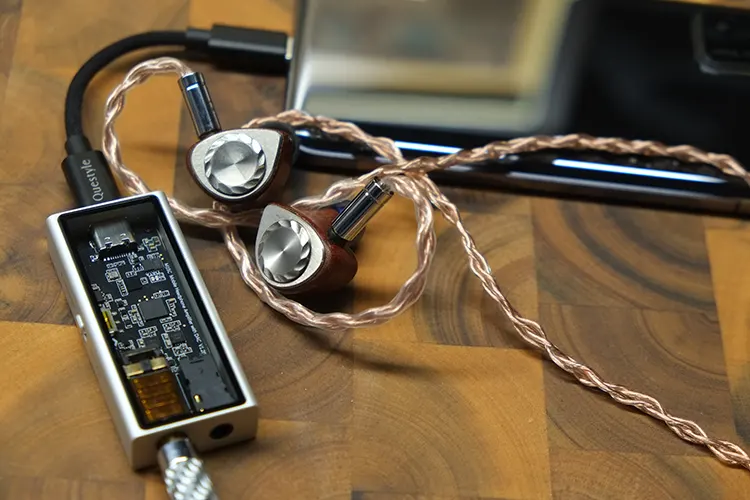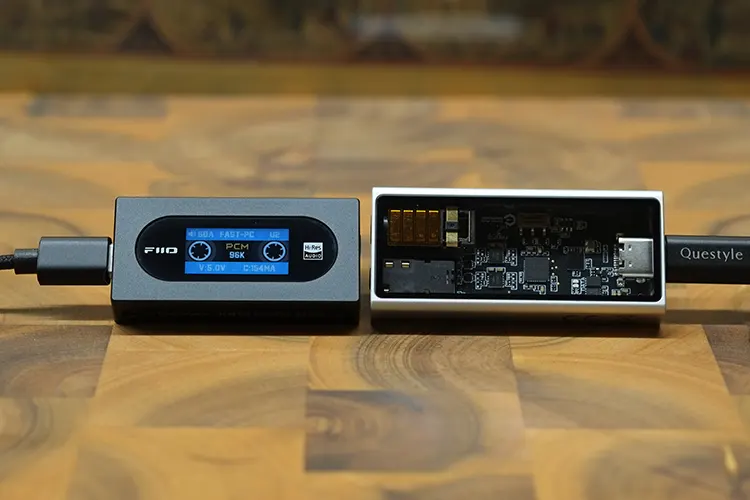Synergy
Due to a high minimum volume and mild noise with sensitive earphones through the balanced output, the M15C is best paired with more average to demanding gear.
The exception is if you like to listen dangerously loud which the M15C will allow, though, for long-term hearing safety it’s not recommended.
Efficiency
With sensitive earphones, like the Campfire Audio Andromeda 2020, through the single-ended 3.5mm output the M15C is quiet with a low noise floor and black background. I hear a minor hiss after changing the cable and shifting to the 4.4mm balanced port.
Tossing on something more demanding and difficult to drive, like the Astrotec Phoenix, that hiss is gone and a black background free of interference returns. This is the case regardless of which output you are using.
Power
Bringing earphones and headphones up to a comfortable listening volume and beyond is not something the M15C struggles with. It has plenty of power through either port, with a gain switch adding a small bump of additional power if needed.
The gain switch is a nice addition, but the effect is minimal at best. Outside of when using the M15C as a preamp for pairing to a full-sized stereo or bookshelf setup, the gain feature comes across as unnecessary given the M15C’s already strong output on normal gain.
The Astrotec Phoenix is a hybrid with unforgiving requirements and is something I often use to stress test DACs and amps because most can’t push it properly. The bass driver loses extension and control, and the electrostatic drivers become splashy and harsh.
The M15C’s single-ended output does a surprisingly good job of powering the Phoenix. While there is still splash present in the high end, the lows feel adequately punchy and some volume headroom remains.
Things improve when moving over to the balanced output which is the most suitable way to drive the Phoenix. The treble tightens up and the overall presentation is more controlled and dynamic.
Where the M15C struggles is low-volume listening as I found the minimum volume through either output quite high.
This means I needed to use hard-to-drive products that defaulted to a lower volume level, or an impedance adjuster like the iFi iEMatch to drop the base volume output when plugging in more sensitive gear.
Pairings
Testing the M15C across earphones with various signatures and specifications, it worked best paired to products with specs on the higher end of average, to those that are more demanding, and a signature that is more neutral or with a thick mid-range.
With sensitive earphones, noise was audible from the 4.4mm balanced port. The minimum volume output was also quite high, limiting the M15C’s usefulness for me.
With moderate to more demanding products, the M15C’s presentation was smooth and refined with excellent end-to-end extension. I didn’t hear any audible distortion or notice a negative change to the products’ default signature or technical qualities.
Selected Comparison
FiiO KA15
Technical
The KA15 provides PCM decoding up to 768kHz at 32bits with DSD256 support. The M15C provides PCM decoding up to 384kHz at 32 bits with DSD 256 support.
The KA15 utilizes dual Cirrus CS43198 DACs and dual SG Micro SGM8262 op-amps. The M15C uses a single Cirrus CS43198 chip.
On the KA15, the single-ended output is 19mW @ 300Ω, and through the balanced output, 78mW @ 300Ω. The M15C outputs 10.72mW @ 300Ω from the single-ended output and 42.79mW @ 300Ω from the balanced output.
To compare output, I set my Huawei P40’s volume to 50% and the KA15’s onboard volume to 100% to mimic the M15C since it has no onboard volume control.
The challenging Astrotec Phoenix was used to test the balanced output, while the Effect Audio PILGRIM NOIR was used to test the single-ended output.
While the specifications might suggest otherwise, the M15C’s volume was significantly louder. This was the case for both single-ended and balanced outputs.
Design
FiiO’s KA15 has a more complicated design. The aluminum shell wraps around a 0.92-inch IPS display with volume, desktop mode, and menu buttons down one side, with a type-C port and 3.5mm single-ended and 4.4mm balanced ports at either end.
The M15C’s aluminum shell wraps around a clear viewing window allowing the user to check out the electronics within. A gain switch is found on one side with a type-C port and 3.5mm single-ended and 4.4mm balanced ports at either end.
Fit and finish on the FiiO is quite a bit better, if not only because the screen is stuck in tightly and cannot be removed, unlike the viewing window on the M15C.
The model information and some product details printed on the side of the KA15 are also aligned correctly, unlike the same details printed on the back of the M15C.
The frosted aluminum finish on the M15C is just as nice as the black finish on the KA15. The visual appeal of the M15C is more to my liking than the more subtle KA15, though that gap closes once the FiiO’s screen is active, and the retro cassette-inspired graphics fire up.
Performance
The KA15 has become my default DAC thanks to a versatile signature that can be adjusted through the onboard EQ and filter settings. The M15C does not offer an equivalent feature set, so I’ll compare the two in their default states.
The M15C provides more upper treble shimmer than the KA15 with a similar level of presence region clarity and detail. The M15C is airier in the upper regions, giving it a greater sense of space.
The KA15’s note presentation is thicker and warmer in the midrange. The M15C’s clarity and texturing quality see minor improvements over the KA15.
Timbre accuracy is strong from both, with neither shifting products to sound unnaturally bright, dark, bass, dry, etc. They both maintain a natural presentation, though I prefer the KA15’s meatier mids that come across as more engaging to my ears.
The M15C provides more sub-bass rumble than the KA15, but less mid-bass warmth and weight. Texturing and detail from the M15C are also a slight step above the KA15.
Both offer stellar staging qualities with the M15C having a small advantage as it provides more width and depth.
Imaging, layering, and instrument separation qualities are equal through the 3.5mm output, with the KA15’s 4.4mm balanced out offering a subtle amount of additional depth.
My Verdict
The Questyle M15C is a competent dongle DAC with a cool look and plenty of power to drive demanding products.
The viewing window into the internals is a conversation starter and the addition of both single-ended and balanced outputs makes me wish this were a universal feature on anything with an auxiliary output.
While the materials used to build the M15C are of excellent quality, Questyle would benefit from additional attention to quality control. One side of the viewing window on my review sample was separated from the device out of the box, and with a little coaxing could be removed.
I fully expect this is an exception to their usual standards, however, it’s worth noting for prospective buyers. Beyond this, I found the M15C to be well-built, and I especially liked the texture of the powdered aluminum exterior.
The strong power output is a double-edged sword. While it means the M15C can drive even the most demanding earphones with headroom to spare, it struggles to provide suitably low listening volumes.
The M15C is overall a good product, but the rough edges I experienced make it hard to recommend given more refined and feature-rich options exist in a similar price range.
Questyle M15C Technical Specifications
- DAC Chip: Cirrus Logic CS43198
- PCM Decoding: Up to 384kHz/32bit
- DSD Decoding: DSD64/128/256
- Output Power:
- 5mm: 10.72mW @ RL=300Ω
- 4mm: 42.79mW @ RL=300Ω
- Frequency Response: ±0.1dB (20Hz-20kHz)
- THD+N: 0.00028%
- Material: CNC Anodized Aluminum Alloy
- Dimensions: 61.9 × 27.9 × 12mm
- Weight: 8g






